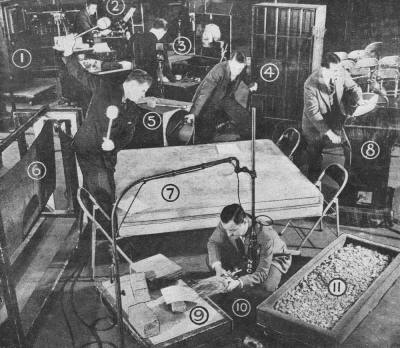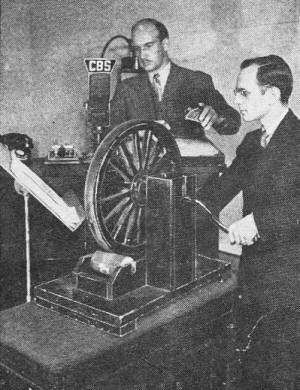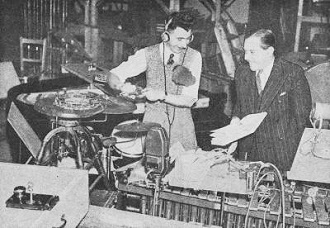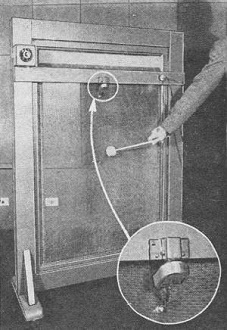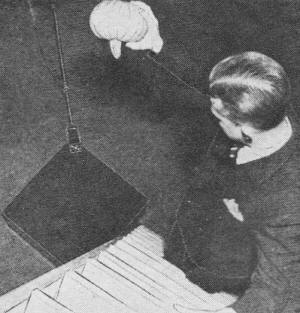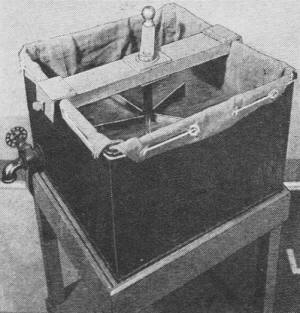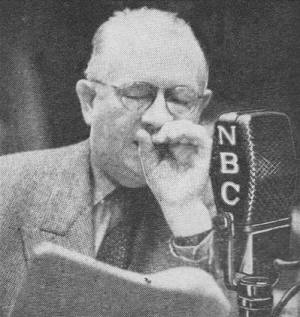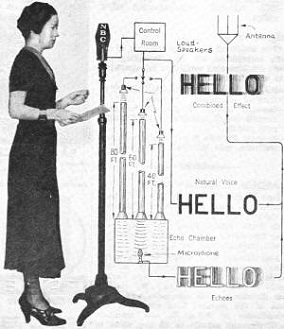Unique Sound Effects in Radio
|
|
Sound effects in television and movies are in the modern era generated electronically at the push of a button or the clicking of a mouse. Thousands of sound effects are available for download to enhance amateur videos. Whether you need the clopping of horse hooves, birds chirping, a street racer squealing his wheels coming off the starting line, or a baby crying in the background, it's all at your disposal - and usually at no cost. Prior to around 1960, with the exception of the incredibly phony sounding "canned" laugh tracks and audience clapping used on "live" situational comedies and variety shows, all those aforementioned sound effects had to be created real-time in the recording studio. Even if you are too old to have actually listened to old time radio shows like The Lone Ranger and The Shadow, surely you have watched an old movie where a gun shot was heard or footsteps on a wooden floor. Almost certainly those sounds were made by somebody using one of the methods shown in this 1939 article from Radio−Craft magazine. Here is avideo on YouTube showing an actual old time sound effects recording studio. Those folks were pretty ingenious. Unique Sound Effects R. D. Washburne Some of the sound effects used at the National Broadcasting Company studios today are shown in the above scene at Radio City studios. (I) An automobile door, (2) turntable for playing recorded sound effects, (3) "wireless" (radio) code oscillator, (4) jail door. (5) echo chamber. (6) electric thunder sheet for high explosives and thunder, (7) thunder drum for small explosives, distant cannon, thunder, (8) splash box for water effects, (9) concrete walk for footsteps on pavement, (10) straw for sounds in underbrush, (11) gravel pit for walking in gravel. The professional Sound Effects Man came into existence about 10 years ago. Modern programs, as for instance the Wells-Welles "War of the Worlds" broadcast of a couple months ago, attest to the dramatic value of his trade today. Neanderthal man may have been the first to employ sound effects - 50,000 to 100,000 years ago - when, in order to distract the attention of game he was stalking, he threw a pebble to create the illusion of action at a remote point. It was not until 10 years ago, however, that the Sound Effects Man really achieved professional status; in 1929 the National Broadcasting Company created a Sound Effects Department and put in charge the man who still heads this department as its Chief Technician - N. Ray Kelly. Until then sound effects had been produced, when provided at all, by a snare drummer, the traditional sound effects man of the old theatre. Despite the considerable degree of candor with which sound effects men discuss their art, still, it reeks of "trade secrets"; and employs all the wizardry expert technicians are able to muster in order that such "scenery" will supply broadcast programs with the proper acoustical backdrop. One of the most "exclusive" occupations in the world, less than 100 men are professionally employed in the trade, one network estimates. Since the general activities of these men have been described at considerable length in newspapers and magazines, including Radio-Craft, it is for this reason that only the more unusual and newest sound effects they have developed are here described. Columbia Broadcasting System, National Broadcasting Co., and the British Broadcasting Corp. have cooperated in making available to Radio-Craft readers the following descriptions of unique sound effects. C.B.S. A horse and wagon lumbers along a rough mountain road - in the C.B.S. studios! A small wagon wheel is turned by Henry Gauthier, &.·Walter Pierson works 2 cocoanut shells in sand, for the horse. In a laboratory on the 13th floor of the C.B.S, building, C.B.S. sound effects engineers have developed a big improvement on the old-fashioned hand telephone. Formerly, when a script called for telephone sound effects, the sound effects engineer had to ring a bell, then pick up a dummy phone set. Or if the actor in the script was to' dial, the sound effects man had to dial on a phone set and make the sound of the ringing current or busy signal with separate buzzers. Today, all this can be done on one piece of equipment - a specially-built phone set attached to a neat little black box about 8 x 8 x 4 ins. Inside the box is a battery which controls the bell, the ringing current, and a "busy" signal. The C.B.S. Sound Effects Department has 20 such highly-condensed phones. Also there are 5 specially-built switchboards. They were made from the parts of an actual switchboard, bought from the telephone company. There are 3 plugs to each switchboard, and flipping a little key gives you a triple choice of bass, baritone, or tenor buzz. There's an anchor machine, too. It consists of 2 horizontal bars with a chain slung over them, turned by a hand crank. It will give you, on the air, the sound of a gang plank being lowered, or the lowering of an anchor. Walter Pierson, Sound Effects head, and his assistant Max Uhlig, shopped for one whole day in a chain factory, selecting the right chain to use on this machine. They went around the factory with hammers, tapping at all the chains to discover the one with the right resonance. Even the old-fashioned thunder drum has been replaced by an electric one - a big square of stretched screen wire to which an ordinary phonograph pick-up has been soldered. When the screen is struck with a padded drumstick, the vibrations are picked up and fed through a speaker to the microphone. You can't even hear this thunder without the speaker. Such exotic sound as the whir of meteors. rushing through space are taken care of quite scientifically, too. In the Columbia Workshop production of "The Wedding of the Meteors" (a good script for experimental work in college radio guilds and such groups), for instance, they used a wind machine, pitched very high in frequency, along with music, and, as the meteors approached the earth, they "faded-in" a dynamo hum on records. Styx Gibling (left), drummer of the B.B.C. Variety Orchestra, discusses with John Watt Director. of Variety, his efforts for the recent broadcast version of Snow White and the 7 Dwarfs. As Gibimg , seldom had time to watch the conductor, he listened to his cues through head phones. Another pretty imaginative effect was that of the voice of "Alice in Wonderland," another Columbia Workshop production, as she grew bigger and bigger after drinking from the bottle the White Rabbit had left on the table outside the Garden. They put Alice in a gobo, a sound effects screen with one "live" and one dead side. Alice stood on the alive side and talked in a very little voice. Then, as she grew, her voice was fed through an echo chamber, which is a long, acoustical labyrinth adding reverberation to the voice. A simple, yet somewhat effective echo effect can be produced by placing a dynamic microphone, face down, in the hole of a grand piano sounding board. With the top of the piano half-open and the dampening pedal held down so as to leave the strings free, voice or sound effects are directed into the open piano. The strings of the piano start to vibrate and give a microphone pick-up that simulates an echo. This has been effectively used on such a program as "Renfrew of the Mounted." The Sound Effects department is never free from the possibility of emergencies. One night, during a "Gangbusters" broadcast, sound effects engineer Ray Kramer suddenly discovered that the hose through which he meant to blow bubbles in a tank of water to represent a drowning man, was missing. The cue was coming up. There was nothing for Kramer to do but start to drown himself. He ducked his face half into the tank and blew his own bubbles the way nature would have done if she'd been consulted. (The tank is a metal one, with a canvas lining to prevent picking up the sound of water slapping against the sides. Kramer removed the device, which when turned, gave the effect of lapping water.) This is C.B.S's new electric thunder screen of copper gauze, with phono pickup on top crossbar. Top-right, studio loudspeaker lead; top-left, gain control. One of the most amusing sound effects - it got a good chuckle out of Pierson himself - was the one Max Uhlig used to milk a cow over the air. He used 2 ear syringe bulbs filled with water and a big bucket. It was perfect. Leaving this network, let's see what's new in sound effects on a competitive net. N.B.C. The increasingly high fidelity output of broadcast receivers and proportionately table outside the improved frequency response of the receivers themselves have made it not only possible but necessary that sound effects be altered to suit the trend. Thus we find that shots are no longer produced by whacking a stick across a carton or the padded seat of a chair. Instead, real .22 or .38 pistols are used at the National Broadcasting Co. Before the department was established, the sound of a closing door was made by dropping the lid of a studio piano, but now there are 25 real doors, in portable frames, that supply the door-closing wants of broadcasting in Radio City. Door-closing and bell-ringing are the commonest sound effects used. For several years salt poured over crisp lettuce leaves was the standard sound effect for rain. The rain machine in use today at N.B.C. headquarters, however, is a complex machine that now produces the sounds of 5 different degrees of rainfall. The secret to the faithful sound is the controlled sprinkling of birdseed upon gauze impregnated with cellophane and stretched taut in a frame, and upon 4 other surfaces each of which produces a sound of slightly higher frequency. Cellophane, incidentally, is a versatile mimic itself. Crumpled properly in the skilled hands of the N .B.C. sound technicians, it sends through the microphone the sounds of frying eggs, burning wood, the snapping of dry twigs as they are trampled upon. N.B.C.'s "body of man falling to street" sound is accomplished with a squash (of squash, not man). For a drowning act, C.B.S.'s Ray Kramer removed the "innerds," dunked his head, and bubbled. For a "telephone voice," N.B.C. actor John MacBryde, pressed nose & talked through cupped hand. The sound of swishing water made in the Show Boat broadcast and others requiring such "scenery" is nothing more than a miniature reproduction of a steamboat stern-wheel turned by a crank in a tub of water. A rocking tub of water makes a noise like waves, and common household brushes make a perfect imitation of the wash of surf. The chief technician was asked one day to make a noise like 2 men crashing through underbrush. He picked up a whisk-broom experimentally and crushed it in his hands. It did the trick. Scores of new streamlined sound effects have been installed in Hollywood Radio City (California) as part of the expansion which followed the opening of the new National Broadcasting studios. Most impressive of the many gadgets added to the N .B.C. sound effects department's inventory is a gigantic thunder drum, whose notes will soon be heard in dramatic programs from Hollywood. More than 6 feet square in its finished form, the thunder drum was manufactured from a steer hide that measured 7 feet square. The unique sound effects drum was manufactured in New York to specifications drawn by Harry Saz, chief of N.B.C.'s sound effects department in Hollywood. More thunder will come from a new type thunder sheet, made of phosphor bronze. The sheet of bronze, 4 feet long and 6 inches wide, gives the same effect as an old-type thunder sheet of galvanized tin 14 feet long. Echo Chambers The lonesomest studios in Radio City (New York) are 3 small chambers opening off a narrow corridor on the 9th floor. The only persons who ever visit them are occasional engineers who test the microphones and the nearby amplifier to make certain that everything is in order. Even to enter them, the engineer has to open 2 heavy soundproofed doors, the one immediately behind the other. It is extremely doubtful if an artist ever set foot in one of these rooms, yet voices and music frequently fill the barren spaces. Recently, when millions of N.B.C. listeners gave ears to Snow White's wishing song on the Rudy Vallee and Johnny Presents program, they became aware of fine resonant echoes. They visualized the wistful princess as singing into the wishing well. That was when the singer's voice rang through an N.B.C. echo chamber. A radio echo is easy enough to supply, but the fellow who wants one in his program positively has to notify the engineering department. in advance. The artist may supply the sound, but the engineer has to furnish its echo - long, short, loud or soft - any kind the artist wants. The technical lads, however, must have a little time to get their echo factory connected with the program. The N.B.C. engineers have, during the 6 years they have used echo chambers, evolved some neat little tricks. They can, for instance, tack an echo onto one sound and broadcast another sound, from the same studio, "straight." This comes in handy in broadcasting, say, a scene from an antechamber off a great hall where the music of an organ reverberates in vast spaces. It was also used in the 2 broadcasts of Snow White's wishing song, except that here the studio engineer had to do some fancy switching, on and off, of the echo chamber. The artist actually sang the echoed phrases twice; but only the repetition was routed through the echo chamber. Once the echo chamber has been linked to a program, the key man is the studio control engineer. He controls the amount of echo with a special "fader." Let us say that a pair of actors is supposed to be mounting stairs to a large barren hall. The actors in the studio actually stand still and read their lines into the microphone. All the "walking" is done by sound effects men at a separate mike. The door also opens with the assistance of the sound effects man. Then the control engineer switches on the echo chamber. The next words have a fine large echo, "footsteps ring out as in a vast, empty space. What has happened? The electrical energy representing footsteps and voice has been split. One part was diverted to the echo chamber where it was strengthened and then reconverted into sound in 3 loudspeakers. Each of these loudspeakers is connected to long, cement-lined tubes. One of the tubes is 40 feet long, another 60 and the third 80. All terminate in conventional horns opening into the echo chamber proper. Sound travels slower than electricity, which has the speed of light. It is apparent also that a sound will be staggered in the 3 tubes. It will come out of the shorter tube first, followed by the same sound at the briefest of intervals from the second and third tubes. That, in itself, is a fairly good start on an echo; but N.B.C.'s engineers like to add a few hundred more faint footsteps and voices to echo the original sound. So they release it into an echo chamber. This is a room, about 8 feet high, 8 feet wide and 16 feet long. The floor is of cement, covered with a fine-grained linoleum. Walls and ceiling are of smooth, hard plaster, covered with a glossy paint. Altogether, the footfalls and voices have every encouragement to bounce around and multiply before they are picked up at the other end of the room by another microphone. Then these synthetic echoes rejoin the main transmission line where they follow the original sound. All of this, of course, happens in seconds. There is a slight echo in the main studios at Radio City, but this is considerably less than half the echo in an ordinary living room. (The studio echo measures about 75/100 of a second, while an ordinary living room has a reverberation period of about 1 1/2 seconds, and the echo chamber, bare, resonant and hard, has a period in the order of 3 seconds.) Recorded Effects Until 4 years ago, every sound required had to be produced in the sound effects workshop, frequently requiring intricate operation in the studio. The craft of providing sound effects had grown to such proportions by then, however, that the first of 7 companies now providing phonographic recordings of sound effects began to offer N.B.C. any and every sound that could be captured and canned. Echoes While You Wait! Echoes as you want them - long or short, loud or soft - are now available upon request. The "echo chamber" does the trick. Sound projected into a short medium or long room - cement-and-linoleum lined - bounces around and around, until it finally reaches a microphone at the far end as d short, medium or long echo, respectively, at N.B.C. With all the multitudinous sound effects still produced in the broadcasting studio, the N.B.C. library of sound effect recordings consists of about 1,000 discs capable of furnishing the astonishing total of 4,000 different sounds. One record has the sounds of screams, snoring and typewriting all on one face; and another offers 20 seconds of a Model T Ford running continuously, 40 seconds of the same vehicle starting, running and stopping, and 20 seconds of a Collie dog barking. The library provides numerous common sounds such as railroad trains, airplane motors, shouting and applauding crowds and animal sounds. At that, it is not infrequent that a perfectly live actor will be called in to a studio to roar like a lion or crow like a rooster because the necessary sound produced that way .can be cued into the continuity with less chance of delay. It is the sound effects department's policy to use phonographic records only for such sounds as cannot be produced practically within the studio in some other manner, but since railroad trains, airplanes and many other cumbersome affairs cannot very well be hauled into the studios the turntables are whirling their phonograph records much of the time. In Hollywood Radio City, new record cabinets, containing 884 bins, hold hundreds of sound effects records, which contain a total of more than 7,500 different sounds, ranging from bird songs to artillery fire. Historical in its significance is a record of the actual sound of Hitler's entrance into Austria. Marching troops, bursting bombs and rolling artillery wheels can all be reproduced from N.B.C. records. When New York was in the grip of hurricane winds, sound engineers caught the howling of the gale high up in Radio City. The sound of the hurricane will be heard by N.B.C. listeners through a record added to the Hollywood library. Church bells, the roar of the China Clipper, the rhythm of the goose-step and the screech of a skidding automobile in the Vanderbilt Gold Cup race are a few of the contrasting effects available on records. There is even a record of the actual swarming of bees! 3 Men on a Sound Set-up At N.B.C. it's every man for himself, when it comes to operating the 9 sound-effects turntables shown above. The record library includes over 4,000 different sound effects; how many could you think of, offhand? B.B.C. When the British Broadcasting Co.'s turn came to do a sound effects job on a broadcast version of "Snow White, etc.," the subject was handled quite differently from the N.B.C. treatment mentioned above. A pair of scissors and a bowl of pea soup are hardly orthodox "instruments" for use in an orchestra, but Styx Gibling, the drummer, used them as 2 of the many effects he invented for the recent broadcast version of "Snow White and the 7 Dwarfs": he clicked the scissors in front of the microphone to represent the squeaking of mice, and blew down a tube into the pea soup to make the "witch's cauldron" bubble. An issue of the Times of India some time ago disclosed another unique sound effects arrangement used by B.B.C. to air Robert Louis Stevenson's thriller-novel, "Markheim." In the story, Markheim murders a dealer in antiques, urged on by the inner voice of his mind and afterwards he is visited by an hallucination in the shape. of Mephisto. It can be readily understood that such a plot, which makes great demands on sound and comparatively little on the visual powers, is ideal for radio. But the producers were up against difficulties in "casting" 2 voices, both disembodied. The mind of Markheim and Mephisto. However, aided by the engineers, they employed a very effective method. Two separate actors were used and a touch of reality was given to their promptings by the way in which the sound control department manipulated their voices. The "inner voice" of Markheim's mind, as played by one actor, had its harmonics filtered out, and was small, but clear yet unreal. Mephisto, once again with the aid of the engineers who had to control separate microphones, had a similar voice but was allowed to have full harmonics added.
Amazing Short Film on Old Time Radio Sound Effects: "Back of the Mike" (1938)
Posted January 17, 2023 |
|

